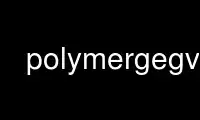
This is the command polymergegv that can be run in the OnWorks free hosting provider using one of our multiple free online workstations such as Ubuntu Online, Fedora Online, Windows online emulator or MAC OS online emulator
PROGRAM:
NAME
polymerge - merge coincident vertices, collinear edges, coplanar faces in an OOGL OFF
object
SYNOPSIS
polymerge [-v vertex_thresh] [-e edge_thresh] [-f face_thresh] [-V] [-E] [-F] [-d] [-b]
[inputfile.off]
DESCRIPTION
Polymerge eliminates redundancies from polyhedral objects in OOGL's OFF format, and writes
another OFF object to its standard output. (Optionally it can produce instead an input
file for Brakke's Evolver.) Specifically, it combines nearly-coincident vertices, nearly-
collinear edges, and nearly-coplanar faces. Vertices which aren't used on any face are
deleted, as are faces with less than three vertices. Thresholds for approximate equality
are adjustable from the command line. Options are:
-v vertex_thresh
Merge vertices when they're closer than vertex_thresh apart; the default is .00001.
-V Don't attempt to merge vertices.
-e edge_thresh
Merge edges where |sin(vertex_angle)| < edge_thresh; the default is When edges are
merged, the corresponding vertex is removed.
-E Don't attempt to merge edges. (4OFF edges are never merged.)
-f face_thresh
Merge faces sharing an edge where the faces are nearly coplanar: when
|sin(angle_between_face_normal_vectors)| < face_thresh. The default is .03, or
about two degrees. Note that merging can create faces which are concave polygons.
-F Don't attempt to merge faces. (4OFF faces are never merged.)
-b Produce an output file in .fe format for Brakke's Surface Evolver, instead of a new
OFF file.
-d Include debugging information as comments in the new OFF object. The comments
indicate which vertices and faces in the original object correspond to which in the
new one. Messages include:
# Vtx nnn->mmm
Merged vertices nnn and mmm (both indices in the original object).
# Merged face nnn into mmm (vertices vvv www) n1.n2 s
Faces nnn and mmm in the original object were merged; their common edge joined
original vertices vvv and www. The cosine of the angle between the face normals
was s.
vertex coordinates # newvertno [order] # oldvertno
Each vertex written appears with its new index, its order (number of edges touching
that vertex), and its old index (index of a corresponding vertex in the original
object).
face description # oldvertno ...
For each new face, with N vertices after reduction, the comment indicates N
corresponding vertices in the original object.
Use polymergegv online using onworks.net services
